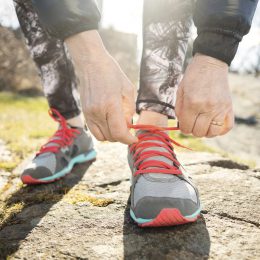10 Things That May Be Causing Your Lower Back Pain
The first step to getting relief is uncovering the root of the problem. Here’s how to decode your pain and then fix it.

Back pain has many causes. In older adults, it’s often linked to gradual wear and tear of the spinal discs, which begin to dry up and shrink over time—almost like the tires on a car.
“If you drive your car faster and harder, those tires will wear out quicker,” says Nick Shamie, M.D., chief of orthopedic spine surgery at UCLA School of Medicine. “The same is true with our discs.”
But unlike those Michelins, you can’t just order new ones. That’s why it’s so important to take care of your back by fixing poor posture, keeping your core muscles strong, maintaining a healthy weight, and trying not to sit too much.
What else you should do: Pay attention to pain!
“Generally speaking, if you have back pain that does not affect the buttocks or legs, you can give it a few days of rest, and it will go away,” Dr. Shamie says.
But if your low back pain does not improve after two or three days, or if the pain radiates out to other areas like your arms or legs, call your doctor, he advises. Seek emergency care if the pain occurs with other symptoms like fever, loss of balance, muscle weakness, incontinence, or pain in your flank—that’s the side of your body between your ribs and hips.
“Help your doctor reach an accurate diagnosis by thinking about how to characterize your pain ahead of time,” Dr. Shamie recommends.
Write down answers to these questions in advance of talking to your doctor:
- Where is the pain?
- How intense is it on a scale of 0 to 10, with 0 meaning no pain and 10 meaning the worst pain possible?
- Does it come and go, or is it constant?
- Does it feel better or worse in certain positions?
The more information you can provide, the better.
To arm you with even more intelligence, here’s a primer on what certain types of pain may indicate.
You Feel: Stiffness in Your Lower Back When You Wake Up
Potential Cause: Arthritis or a Floppy Mattress
Arthritis is inflammation in the joints, and your spine has lots of those. In fact, each vertebra has three: the disc and two facets.
Try this: “Take your index, middle finger, and thumb, and point them down like a three-legged stool,” Dr. Shamie says. “Your thumb would be the disc in the front, and the two fingers in the back are the facet joints.”
Now do the same thing with your other hand, and stack them. That’s how the spine works—many vertebrae stacked one on top of the other.
As the disc joints dry up over time, they shrink and get closer, putting more stress on the facet joints. This leads to inflammation and arthritic pain. The pain typically improves after about 30 minutes and may return toward the end of the day.
Don’t stretch—that’s just as likely to hurt as to help, says back specialist Stuart McGill, Ph.D., author of Back Mechanic. Instead, try taking a morning walk. Walking can be a great pain soother.
Morning pain could also be a sign that your mattress is not supportive enough, McGill says.
What else can aggravate your back: sleeping on your stomach. Try sleeping on your back with a pillow under your knees. Check out more tips to find your best sleep position.
You Feel: Sharp, Shooting Pain That Travels to Your Legs or Arms
Potential Cause: Pinched Nerve or Herniated Disc
Remember all those joints in the spine? Well, between them passes the spinal cord, which splits off into nerve roots that travel to various parts of your body. When these nerve roots become pinched or damaged, you feel pain.
This can happen because as the discs dry up and become stiffer over time, the joints may swell and compress the nerves.
Another potential cause is a herniated or bulging disc. This is when some of the jelly-like substance inside the disc pushes out through a tear, possibly irritating nearby nerves.
See your doctor. Physical therapy may help, along with steroid injections, says Kee Kim, M.D., chief of spinal neurosurgery at UC Davis Health. As a last resort, surgery may also be an option.
You Feel: Sudden Soreness, Tightness, or Spasms After an Activity
Potential Cause: Muscle Strain
Can you link the pain to an activity? That’s probably a muscle strain, which is what happens when the muscle fibers stretch too far or tear.
It doesn’t take a herculean task, says Akhil Chhatre, M.D., director of spine rehabilitation at Johns Hopkins Medicine. “You could just be reaching for a sock under the bed.”
Pain can last one day to several months, depending on how badly it’s strained, Dr. Chhatre says.
If you hear or feel a pop in your muscle at the time of injury, call your doctor sooner rather than later.
Otherwise, avoid any activity that causes the pain to flare up, Dr. Kim says. And apply heat or cold to the area for 15 minutes, four to six times per day. Try both to see which works better for you. If the pain does not improve after two days, call your doctor.
You Feel: Pain, Weakness, or Cramping in Your Back and Legs That’s Relieved When You Sit or Lean Forward
Potential Cause: Lumbar Stenosis
Blame Father Time again. As the vertebrae get closer with age, the space in your spinal canal begins to narrow, Dr. Shamie says. Joints can swell, and ligaments can thicken. And when the nerves no longer have enough room for comfort, pain can set in.
Patients typically say they feel better when sitting or leaning forward, and they may lean on their grocery cart when food shopping.
“When you’re in that position, you actually open up the part of the spine where those ligaments are compressing the nerves,” Dr. Shamie says.
Over time, this can lead to a feeling of weakness and numbness in the legs. It might feel similar to the pins and needles sensation you get when you fall asleep with your arm pinned under you, he explains.
Talk to your doctor, who may recommend physical therapy along with other strategies like over-the-counter pain meds, steroid injections, or a plan to lose weight. Surgery may be considered as a last resort.
You Feel: Persistent, Achy Pain That Gets Worse When Sitting or Bending
Potential Cause: Disc Damage
Do a lot of sitting and slouching? You may be stressing your discs, causing damage over time and leading to pain that may come and go.
“If you get a sharp pain in your back when you bend forward to flush the toilet, swing a golf club, or pick up your grandchild, and then you have a grumpy back for three or four days, that’s most likely discogenic back pain—or pain originating from sensitized discs,” McGill says.
Talk to your doctor about strategies that can help and ways you can safely exercise. For example, a lumbar pillow may help keep your spine in a pain-free position when you sit, McGill says. Exercise is also a good strategy, but it’s important to ease in and listen to your body.
“Some people need much more activity, while others are excessive and will do better with less,” McGill says. “As you get older, we’re much more interested in tuning your body.”
Everyone is different, and your doctor, physical therapist, or trainer can give you personalized recommendations. Here’s a week of workouts McGill generally recommends:
- Every day, walk and do side plank, bird dog, and modified curlup. See descriptions in this guide to core exercises that ease lower back pain. If you have difficulty getting down on the floor, try some of the exercises in this seated core workout instead.
- Choose two days for strength training. Try this full-body strength workout for total beginners or this 15-minute total-body chair workout.
- Pick two days for mobility work. Try this 30-minute stretch and mobility session.
- Save two days for fun cardio. Swimming, biking, and any other heart-pumping activity you enjoy are great options.
- One day per week, rest.
You Feel: Pain Accompanied by Skin Folds on Your Flank or Spine Anomalies
Potential Cause: Scoliosis, Spondylolisthesis, or Other Alignment Issue
In some cases, back pain can be the first sign of adult scoliosis, which is when the discs wear unevenly and lead to a sideways curvature of the spine.
Patients may also notice folds on one flank or feel like one side of the chest is more forward than the other, Dr. Shamie says.
Subscribe to our newsletter
It's quick and easy. You could be one of the 13 million people who are eligible.
Already a member? Click to discover our 15,000+ participating locations.
Follow Us
While scoliosis can alter your appearance from the front or back, another condition—spondylolisthesis—can cause the spine to look curved from the side. That’s when the vertebrae begin to slip forward starting from base of spine.
Both conditions can put pressure on the spinal nerve, causing pain.
Talk to your doctor. Physical therapy, spine braces and orthotics, or steroid injections may help. In some cases, a doctor may recommend surgery.
You Feel: Pain That Travels to Your Butt, Hips, or Pelvis and Gets Worse When Rising from a Chair or Rolling Over in Bed
Potential Cause: Sacroiliitis
The sacroiliac joints are located where the lower spine meets the pelvis, and like any joint, they can become inflamed. This inflammation of the sacroiliac joint is known as sacroiliitis.
“Typically, patients have a lot of pain when they’re rolling in bed,” Dr. Shamie says. “That’s a telling sign—because other types of low back pain typically improve while lying down.”
Talk to your doctor. Left untreated, the condition may limit mobility, but physical therapy often helps.
You Feel: Intense, Localized Pain Near the Spine, Accompanied by Heat and Extreme Tenderness
Potential Cause: Infection
While not common, an infection can spread to the spine.
“As we get older, our immune system may not be as robust,” Dr. Kim says. “So even simple things, like a urinary tract infection—which is more common as we get older—can lead to infection of the spine.”
One telling sign is the severity of the pain, Dr. Kim says. “Quite often when we examine the patient and put our hands to their back, they just jump off the table because it’s so painful to touch.”
Seek immediate care. If left untreated, a spine infection can lead to more serious problems like weakness. Your doctor may prescribe antibiotics or recommend surgery, Dr. Kim says.
You Feel: Disabling Pain in Your Back and Often Legs, Plus Numbness in Buttocks or Incontinence
Potential Cause: Cauda Equina Syndrome
This rare but serious condition results from compression of the cauda equina, the sac of nerves at the base of the spine that travel to the legs and bladder. These nerves send important messages to these parts. And if the nerves get compressed, the messages don’t get sent properly to the bladder, for example—which can lead to urinary incontinence.
Cauda equina syndrome can be caused by a number of things, including disc herniation, spinal stenosis, or injury. Go to the emergency room, Dr. Kim advises. The condition may require immediate surgery.
You Feel: Pain That Occurs with Other Symptoms, Such as Fever, Chills, Night Sweats, Weight Loss, Flank Pain, or Changes in Bowel or Urinary Habits
Potential Cause: Organ Dysfunction or Cancer
Back pain can be the first sign of some pretty serious issues, such as enlargement of the aorta, kidney infection, and even some cancers, Dr. Shamie says.
Sharp pain on one side of the lower back can also indicate a kidney stone.
Keep in mind these are not common reasons for back pain, Dr. Shamie says. So don’t panic. But if the pain is intense, and especially if it’s marked by other symptoms, don’t turn a blind eye either. Seek care right away, he advises.
Take Your Favorite SilverSneakers Classes Online!
SilverSneakers members can access live fitness classes and wellness workshops through SilverSneakers LIVE. See the latest schedule and RSVP for classes here.
Not a member? If you have a Medicare Plan, it may include SilverSneakers—at no additional cost. Check your eligibility instantly here.





